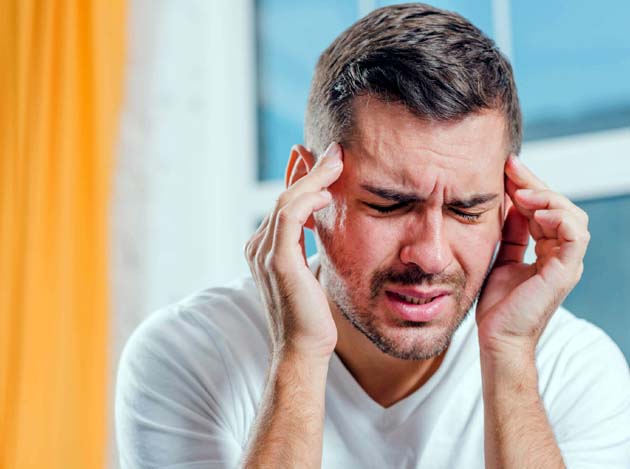Dr Tasaduk Hussain Itoo
Headache is pain in any region of the head which may occur on one or both sides of the head, be isolated to a certain location, or radiate across the head from one point. It may appear as a sharp pain, a throbbing sensation or a dull ache, develop gradually or suddenly, and may last from less than an hour to several days. Headaches can be more complicated than most people realize. Different kinds can have their own set of symptoms, occur for unique reasons, and need different treatments.
For example, tension headaches are the most common type of headache among adults and teens. These are also called stress headaches. They cause dull pain, tightness, or pressure around one’s forehead or the back of head and neck. Some people say it feels like a clamp squeezing their skull. They are usually of two types – episodic tension headaches occur fewer than 15 days per month; while as chronic tension headaches occur more than 15 days a month. These headaches can last 30 minutes to a few days.
Migraine headaches are often described as pounding and throbbing pain. Along with the pain, people have other symptoms such as sensitivity to light, noise, or smell; nausea or vomiting; loss of appetite; and upset stomach or belly pain. In many people, these occur in stages. They can last from 4 hours to 3 days and usually happen one to four times a month.
Cluster headaches are the most severe. They are called cluster headaches because they tend to occur in groups. One might get them one to three times per day during a cluster period. One could have intense burning or piercing pain behind or around one eye. It can be throbbing or constant. The pain can be so bad that most people with cluster headaches can’t sit still and will often pace during an attack. On the side of the pain, the eyelid droops, the eye reddens, pupil gets smaller, or the eye makes tears, and the nostril on that side runs or stuffs up.
Sinus headaches occur when cavities in one’s head, called sinuses, get inflamed. One may feel a deep and constant pain in cheekbones, forehead, or on the bridge of one’s nose. The pain usually comes along with other sinus symptoms, like a runny nose, fullness in the ears, fever, and a swollen face. A true sinus headache results from a sinus infection so the discharge that comes out of nose will be yellow or green, unlike the clear discharge in cluster or migraine headaches.
Though, there are multitude of causes and types of headaches (at least 150 types) that need proper evaluation with proper medical intervention, however there are many possible triggers responsible for augmenting headaches in general and tension and migraine headaches in particular — including physical, emotional, environmental, dietary, hormonal and medicinal factors.
The physical triggers include excessive tiredness, getting an inadequate sleep, random shift work schedule, poor posture (neck or shoulder tension), strenuous exercise; while as the emotional triggers include stress, anxiety, depression.
The environmental triggers include bright lights, flickering screens with more screen time (television or computer screen), smoking (or smoky rooms), loud noises, sudden changes in climate — such as changes in humidity or very cold temperatures, strong smells, a stuffy atmosphere, flu or sinus infections.
The dietary factors include — missed, delayed or irregular meals, dehydration, iron deficiency, alcohol consumption, excessive intake of caffeine products(tea and coffee) and their sudden withdrawal, excessive intake of specific foods(chocolate and citrus fruit), excessive intake of foods containing the substance tyramine (cured meats, pickled herrings, smoked fish and certain cheeses).Moreover, frequent use of over the counter pain killer medications can also act as a trigger sometimes and lead to medication overuse headaches or rebound headaches.
Triggers are very individualized/personalized and can be possible factors for augmenting tension/migraine headaches, however it may be helpful to keep a diary to document and identify a consistent trigger. So, recognizing the various triggers for headache, documenting and trying to avoid them — is one of the best ways to prevent headache episodes or decrease their frequency.
With regard to other prevention strategies of headaches, which include — biofeedback; cognitive behavioural therapy; acupuncture; massage therapy; physical therapy; deep breathing; meditation; hypnotherapy; building positive support network; exercising regularly; drinking plenty of fluids/water; eating regular, balanced and healthy meals without skipping; getting adequate sleep; avoiding alcohol consumption/ smoking; limiting caffeine intake; limiting OTC pain killers; keeping a diary to spot on triggers; encouraging positive sense of humour without hurting others; and taking supplements like coenzymes, multivitamins, magnesium etc.
(The author is a medico/educator)
Trending Now
E-Paper


